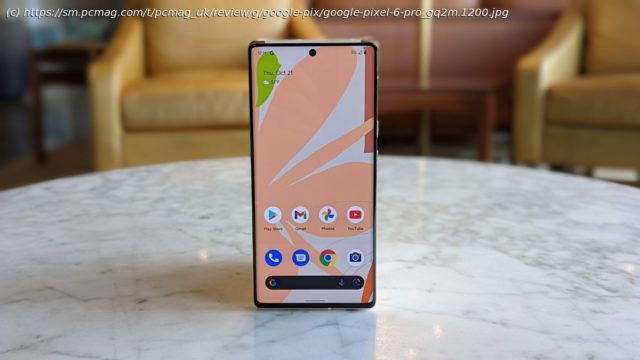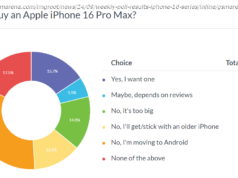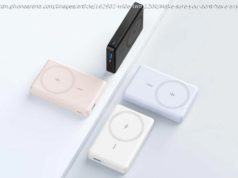Google nails the Android flagship at an affordable price
The Google Pixel 6 Pro (starting at $899) is the company’s most ambitious smartphone to date, and a major improvement over last year’s Pixel 5. Now, the Pixel 5 was a fine phone, with an excellent camera, good performance, and a lot of value for the price, but it was also a bit boring. With the Pixel 6 Pro, Google overhauls everything inside and out. The phone sports a new Tensor chip that delivers superb performance, a vivid OLED panel, and a battery that lasts all day. It’s the most expensive phone in Google’s lineup, which includes the Pixel 6 (starting at $599) and the wallet-friendly Pixel 5a With 5G ($449), but it stands out as the best high-end Android you can buy right now, earning our Editors‘ Choice award for Android flagships. Unconventional Design You won’t mistake the Pixel 6 Pro for any other smartphone. With a design that toes a fine line between elegant and offbeat, it’s refreshing to see Google step away from the generic glass sandwich we’ve come to expect. The phone measures 6.5 by 3.0 by 0.4 inches (HWD) and weighs 7.4 ounces. These dimensions are pretty common for a flagship, but it might be on the large side for people with small hands. It’s available in three colors, including Cloudy White, Sorta Sunny, or Stormy Black. The Cloudy White version is all gray with chrome rails and trim. Sorta Sunny is an understated mix of peach and sand with gold detail. And Stormy Black has a subdued two-tone back panel with glossy rails. A 6.7-inch LTPO OLED display dominates the front of the phone. The bezel-less panel sports an adaptive refresh rate between 10Hz and 120Hz. Its resolution comes in at 3,120 by 1,440 pixels, which equates to a super-crisp 512 pixels per inch. Colors are vibrant but accurate, with immersive, inky blacks. Viewing angles are solid, and it’s easy to see the phone in direct sunlight. The Pixel 6 Pro has an idiosyncratic design The in-display fingerprint sensor is on par with the one in the Samsung Galaxy S21 Ultra. It’s pretty fast and has a 95% accuracy rate. It’s also among the easiest to set up that we’ve used. On the glossy back of the phone, a chunky camera bar creates a boundary between its complementary color blocks. And while the protruding camera bar stands out, it doesn’t affect the phone’s usability. We couldn’t get the handset to wobble or teeter when placing the phone on a flat surface. A glossy aluminum chassis sits between the display and curved back. The left and top edges are bare, while the right side houses a power button, a SIM card slot, and a volume rocker. Instead of the textured buttons found on most other phones, Google goes with a matte finish; the buttons look more attractive and are easier to press, with a satisfying click. The bottom is home to a USB-C charging port and dual speaker grilles. With a Gorilla Glass Victus display and back, the Pixel 6 Pro should easily withstand the minor drops and dings that accompany daily life. And with an IP68 rating, you don’t need to fret over a splash or drop in the tub. The Pixel 6 Pro packs a 5,003mAh battery. In our battery drain test, in which we stream HD video over Wi-Fi at full brightness, the phone lasted an incredible 22 hours and 18 minutes before powering down. With moderate daily use, you can easily get two days between charges. As with other flagships, Google doesn’t include a power adapter in the box. That said, the Pixel 6 Pro supports 30W fast charging via USB-PD 3.0 and is compliant with third-party adapters. Qi wireless charging tops out at 12W, but the upcoming Pixel Stand 2 supports fast charging at up to 23W. Reverse charging is also in the mix. Life in the Fast Lane The Pixel 6 Pro ships unlocked from Google and has a SIM slot as well as an eSIM. It works on every major US carrier’s LTE, mmWave, and Sub-6 GHz networks, thanks to extensive band support. There’s also C-band connectivity for improved mid-band 5G that should start popping up on networks soon. Google lists only one version of the Pixel 6 Pro for the US, but if you purchase your phone directly from a carrier, make sure it’s not locked to that network. We tested the Pixel 6 Pro on Verizon’s 5G Ultrawide Band network in Chicago and recorded admirable speeds. Verizon has a huge mmWave footprint in Chicago and our speeds averaged 1.7Gbps down and 102Mbps up. We also tested the phone on Verizon’s nationwide 5G network in Milwaukee, Wisconsin and its surrounding suburbs. Speeds averaged 228.6Mbps down and 64.2Mbps up. What’s most impressive, however, is that the Pixel 6 Pro consistently beat the iPhone 13 Pro and Samsung Galaxy S21 Ultra at dozens of test sites. When we ran speed tests while doing our camera evaluations in densely wooded areas, the Pixel 6 Pro always had a solid signal; in comparison, the iPhone defaulted to LTE and the Galaxy S21 Ultra simply had no signal. The phone supports 30W charging via USB-PD 3.0 We reached out to Google to learn more about the Pixel 6 Pro’s 5G modem, but a representative for the company told us that it is not disclosing details about it. After some digging with Sascha Segan, PCMag’s lead mobile analyst, we confirmed that the phone uses Samsung’s Exynos 5123 modem based on its baseband software. The Exynos 5123 is the same modem in the international models of the Samsung Galaxy S20 series. The modem supports 800Hz mmWave connectivity and 200MHz of Sub-6GHz 5G. According to Segan, „It’s unclear whether the Exynos can do n41+n71 or n77+n5 carrier aggregation for next-generation standalone 5G performance the way Qualcomm’s X60 modems can, but we also haven’t found any of those schemes in the wild yet—that’s a future feature.“ The Pixel 6 Pro also supports Wi-Fi 6E.






